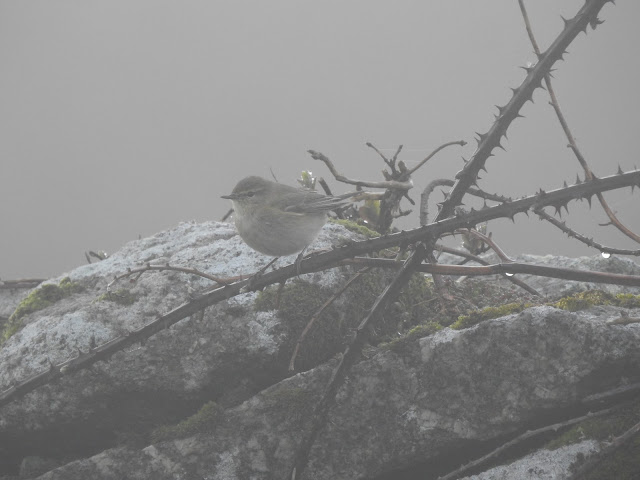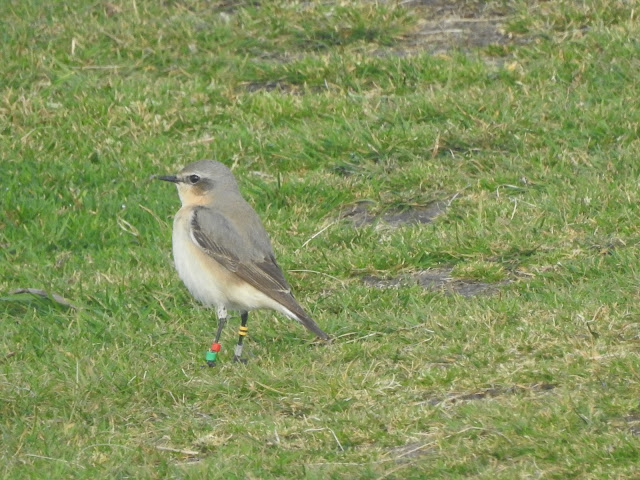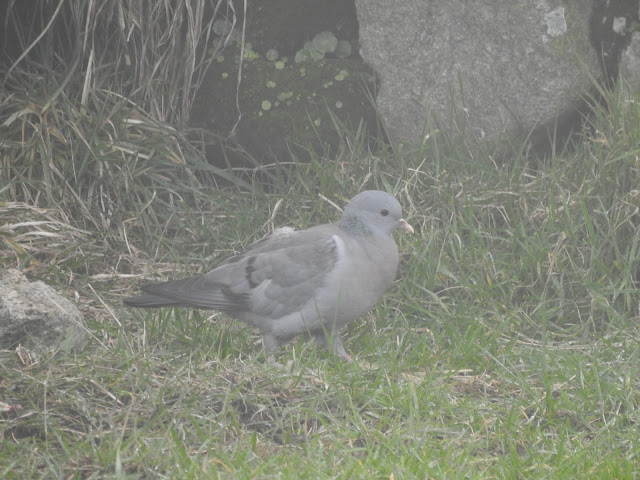Moderate to strong southwesterlies all week with occasional rain. Calm and light northerly winds on 26th.
A total of eight Teal were seen on 24th and 26th. A female
Shoveler flew over the Village on the evening of 21st. A high count of eight
Woodpigeon were recorded on 24th. Single Water Rail were heard in Millcombe on
20th and 26th. A Black-headed Gull flew north past South West Point on 26th.
A single Golden Plover was heard flying over the island from
20th to 22nd. A Curlew landed in Brick Field after the low cloud cleared in the
late afternoon on 20th. A Woodcock was flushed from along the Lower East Side
on 23rd and a Jack Snipe was flushed around Pondsbury on 24th. The nine Purple Sandpipers were still at
Brazen Ward on 25th.
The strong winds cleared all the Auks off the cliffs with
only 115 Puffins and 20 Guillemot returning to Jenny’s Cove on 26th. Up to two
Great Northern Divers were seen from the Landing Bay from 23rd to 26th. A
single Red-throated Diver was further out on 23rd. Manx Shearwater are starting
to arrive in larger numbers with 200 counted of South West Point on the morning
of 26th. A Cormorant flew west past the Castle on 25th and possibly the same adult
was seen on Miller’s Cake on 26th.
The female Sparrowhawk was seen on multiple occasions this
week, as was the female Merlin. A high count of nine Peregrine were counted on
26th. The Jackdaw remains around High Street Field.
There were few hirundines this week, 10 Sand Martin were
counted on 26th. A Swallow flew through on 22nd and eight and 14 were seen on
24th and 26th respectively. The first Willow Warbler of the year was in
Millcombe on 21st. The lighter winds and rain overnight brought in a few
migrants on 26th. Four Willow Warbler, two Blackcap, 19 Chiffchaff, 25
Goldcrest and two Firecrests were seen across the island with possibly more
moving throughout the day.
 |
| Firecrest, Millcombe © Stuart Cossey |
A few late winter thrushes were on the move this week. A Fieldfare was seen in Millcombe on 23rd and Redwing were noted on 22nd and 25th. A female Black Redstart was below Benjamin’s Chair on 26th and a total of 16 Stonechat were counted on 25th. Wheatear are still moving through slowly with 23 on 24th, 18 on 25th and 31 on 26th. There were big movements of Meadow Pipits on several days including 125 on 25th and 290 on 26th. A max of 11 Pied Wagtail and 16 alba wagtail were recorded on 26th and single White Wagtail were seen on 24th and 26th. A Grey Wagtail was heard flying over on 26th. Finches are being recorded more regularly with Goldfinches and Linnet recorded every day. A total of seven Goldfinch were seen on 26th including one seen flying out to sea off the North End. A Brambling fly over the Castle on 26th.
 |
| Wheatear, North End © Stuart Cossey |
 |
| White Wagtail, High Street Field © Stuart Cossey |
In non-avian news, the 25th saw the first day with multiple
butterfly sightings along the Lower East Side including a Small White, Small
Tortoiseshell and Peacock. Three Slow Worms were found in Millcombe whilst
transplanting some trees from the nursery.
 |
| Peacock, Lower East Side © Stuart Cossey |
Contributors: Stuart Cossey, Luke Marriner, Tim Davis, Tim Jones, Helen Cole, Ishbel Hayes, Bee Cox, Alan Rowland
















